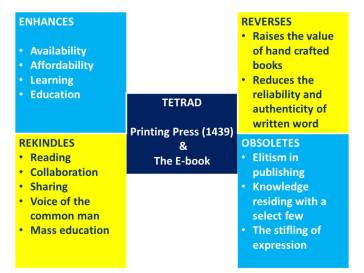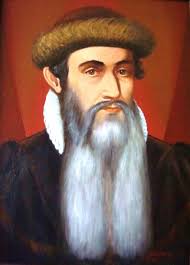The E-Book as a Rhyme of History: A New Spin on an Old Teaching Machine
Nino Varsimashvili is credited with the words “life is the muse which perfectly rhymes…”
As I reflect of technology emergence, I must say I am pleased with the progress I am making through this course. I am recognizing that technology emergence is driven by a number of complementary and sometimes opposing forces that must be considered when there is any reflection on or prediction on emergence. One of those forces is that of the rhyme of history.
When the impact of a new technology revives or reawakens something from the distant past, we refer to that as a rhyme of history (Laureate Education, 2014h). This phenomenon is called a rhyme of history because of the way the “affect” of the technology resembles the kind of impact a technology from the past has had.
In the course Trends and Issues in Educational Technology, I learned that issues are borne out of problems, usually those recurring problems that mankind tend to continually innovate around. I am recognizing now that the rhymes of history, as a driving force for technology emergence, is itself fed by that need we have as human beings to address the issues of our times. The fact that, as humans we are basically the same, despite our differences (even differences in eras and generations), means that some of our problems are the same and some of our issues are the same. As a result the ways we try to resolve those issues, from generation to generation, will resemble each other – they will rhyme.
I am also recognizing that evolutionary force will push a technology into existence, but its impact will carry it along the emergence continuum.
Recently I was asked by a friend to make  a short presentation on the impact of the printing press on the society of 1439. In my quick research and analysis, I found the following impact:
a short presentation on the impact of the printing press on the society of 1439. In my quick research and analysis, I found the following impact:
- Increase in availability of books
- Increase in speed of information spread
- Increase in affordability of books
- Increase in learning
- Increase in sharing of ideas
- Increase in knowledge concentration and proliferation
- Mass education (“Ebook timeline”, 2002)
As I reflected, I recognized glaring similarities with the e-book of today (Hillesund, 2001; Klaava”, 2016). So, you guessed it, I took out the tetrad (Laureate Education, 2014f) to further examine these two important technology breakthroughs. (See 2-in-1 tetrad above.)
For more on e-books check out:
http://klaava.com/books/gutenbergs-printing-press-revolutionized-book-business-just-like-ebooks-are-doing-now/
http://faze.ca/the-future-of-reading-e-books/
Reference
Ebook timeline. (2002). the Guardian. Retrieved from https://www.theguardian.com/books/2002/jan/03/ebooks.technology
Gutenberg’s printing press revolutionized book business just like ebooks are doing now | Klaava. (2016). Klaava.com. Retrieved from http://klaava.com/books/gutenbergs-printing-press-revolutionized-book-business-just-like-ebooks-are-doing-now/
Hillesund, T. (2001). Will E-books change the world?. First Monday, 6(10). Retrieved from http://firstmonday.org/ojs/index.php/fm/article/view/891/800
Laureate Education (Producer). (2014h). David Thornburg: Rhymes of history [Video file]. Baltimore, MD: Author.
Laureate Education (Producer). (2014f). David Thornburg: McLuhan’s Tetrad [Video file]. Baltimore, MD: Author.
The Gutenberg Galaxy. (2016). Google Books. Retrieved from https://books.google.com.jm/books?id=zFc5n4CbsbwC&printsec=frontcover&source=gbs_ge_summary_r&cad=0#v=onepage&q=crude&f=false